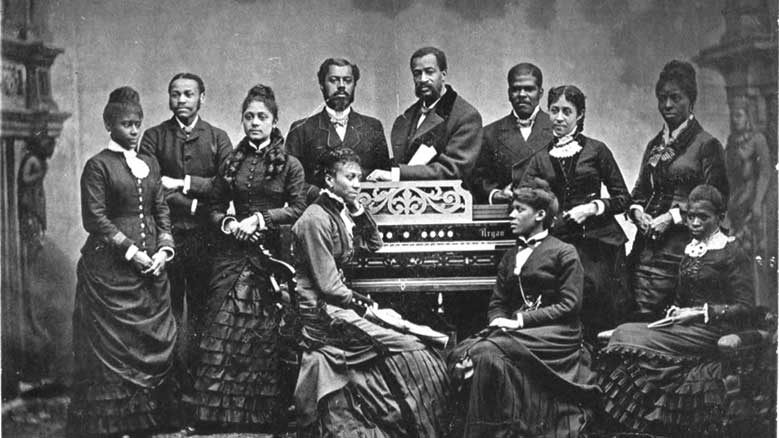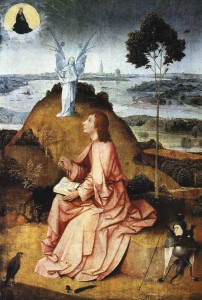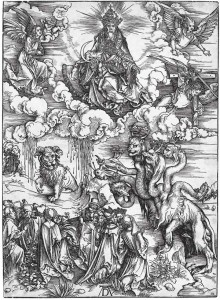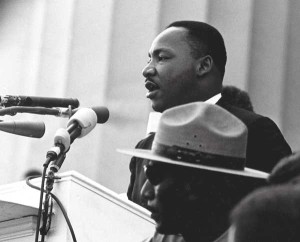
The Apocalypse of John in the Quaker and African American Spiritual Traditions
The Book of Revelation, sometimes called the Apocalypse of John, is the last book of the canonical Christian scriptures. Over the centuries it has been cited as proof that the end of the world was near, yet it was also one of the favorite texts of George Fox and other early Friends. Its imagery informs countless nineteenth-century African American spirituals, and in the twentieth century it inspired the Civil Rights Movement, and Martin Luther King Jr. echoed its structure and language in his most famous speech. The seven-headed monster of the Apocalypse can still be seen in modern struggles for justice.

The author of the book of Revelation, who gives his name as John, is unlikely to be the same person as either John the beloved disciple or John the evangelist. While on the island of Patmos, he had a dream, or a vision, which he proceeds to describe in considerable detail. The text includes many fantastical word pictures describing titanic struggles between good and evil. Many of the book’s images have entered into our common culture: the pearly gates, the four horseman of the Apocalypse, the Seven Seals, the grapes of wrath, Gabriel and his trumpet, the whore of Babylon, the seven-headed monster, and the New Jerusalem.
The book has been controversial throughout Christian history. Many have felt it was included in the canon by some sort of ecclesiastical accident. Others have been much intrigued by the book, and have expended enormous effort trying to untangle its mysteries.
Many have assumed that the text is a linear narrative of history which allegorically describes in exact sequence past, present, and future events. Those who hold this view assume that if they can accurately link up actual historical events with the narrative in the Book of Revelation, it will be possible to determine exactly where in the book’s sequence we are at present, and therefore, what will happen next. In the nineteenth century many people became utterly convinced that the last day, or the Day of Judgement, would occur on October 22, 1844. Thousands upon thousands of people actually expected to see the end of the world on that day. They gathered in churches and on rooftops, some wearing white robes. In Christian history the failure of Christ’s Second Coming to occur in 1844 is known as “The Great Disappointment.”

The general idea that the Book of Revelation predicts the imminent end of the world is by no means dead, however. A contemporary series of 16 bestselling novels, called collectively the Left Behind series, while avoiding a commitment to any particular date, nevertheless vividly describes a modern-day apocalypse in which the saved will be raptured into heaven while the rest of humanity is left behind to face a terrible fate. Total sales for this series of novels have exceeded 63 million copies, and many of the titles have been on the bestseller lists of the New York Times, USA Today, and Publishers Weekly, even though these bestseller lists do not take into account additional numbers of sales made in religious bookstores.
What has all this to do with African American spirituality and with Friends?
George Fox and the Valiant Sixty group of early Quaker evangelists were avid readers of scripture, and they based the essentials of their spiritual movement on their interpretation of scripture. George Fox quoted scripture so extensively that some people went so far as to say that if the Bible were ever lost, it could be completely reconstructed from George Fox’s memory and his writings.
It may surprise people to learn that the Book of Revelation was one of Fox’s favorite texts. In the light of the very brief account I have given of the place of the book in Christian history, one might wonder at George Fox’s interest in it. But Friends saw something in the text that eluded other readers.
There is really nothing in the book which directly states that there is a hidden key which, if discovered, would enable readers to link the visions described with a specific sequence of historical events. There is one phrase in the book which refers to “things which have been, which are, and which will be,” but this could mean simply that what is described is always going on. And like all descriptions of visions or dreams, the bulk of the book is written in the past tense—I saw this and then I saw that—as the vision unfolds.
Fox’s understanding of the Book of Revelation was not that it is a linear description of a time sequence beginning somewhere in the past and moving on to predictions of the future; rather, to Fox the book is a poetic and metaphorical description of what is going on right now. We live in a time when the old world and the old world’s way of doing things is destroying itself in a paroxysm of violence and collapse, a time also when the Second Coming of Christ is visible all around us. For wherever an individual or a company of people turn their hearts to the truth, there we see the dim outlines of the City of God, of the New Jerusalem, coming into view.
What the Apocalypse of John revealed to George Fox was not the end of the world but its rebirth, a rebirth instituted by Jesus and continued by his disciples as the disciples act concretely to advance the cause of justice and truth in human society. Using imagery from the Book of Revelation, George Fox describes this struggle for truth and justice as the “Lamb’s War,” a war carried out by the meek through gentleness, nonviolence, self-sacrifice, and peace. While there is a lot of mayhem and violence in the Book of Revelation, this is violence and mayhem perpetrated by oppressors against each other and against the weak and innocent. The single weapon in the Lamb’s War as described in the book of Revelation is a “terrible swift sword” which proceeds from the mouth of Jesus. In other words, it is not a humanly devised killing machine, but only his truth which goes marching on into battle with the forces of evil.
In centuries following, George Fox scholars came to designate this interpretation of the Book of Revelation as “post-millennialism,” or as “realized eschatology.” These terms simply mean that the Second Coming of Christ has already occurred, and the promised new age, or New Jerusalem, is being constructed as people of faith advance the causes of peace, truth, and justice.

But let us turn from academic theology to consider one of the most remarkable developments in the history of religion: the uneducated community of enslaved people in America developed its own very powerful biblical understandings, understandings recorded not in learned treatises, but in their own wonderful music. While it is true that freed blacks often became educated and sophisticated participants in the public debates of their day, African American spirituals cannot be understood at all unless they are understood as the record of the sacred wisdom of an oppressed people who developed biblical insights as valid and as significant as those of any learned theologian. These insights were preserved and expressed not in scholarly journals and books, but through the medium of music.
First, the enslaved people identified with Israel’s bondage in Egypt and expressed their yearning to be free, often in a desire to be released from this world. “Go Down, Moses,” “Swing Low, Sweet Chariot,” and “Deep River” are songs of this sort.
Second, enslaved people identified with the suffering of Jesus. They could see the suffering Christ as someone whose predicament was somewhat the same as their own. “Were You There When They Crucified My Lord?” is a famous African American spiritual of this sort.
Third, in their own reading of the Bible, enslaved people perceived a clear emphasis: the cry for freedom and justice from the underside of history. Their cry for help from almighty God was also a cry of hope. They saw themselves as a people of destiny, participating in God’s working in history. And it is here that our theme—the Quaker reading and the African American reading of the Book of Revelation—comes into focus. For associated with the cry for freedom was an expectation of the justice and the judgement of God. “Judgement Day Is a-Rollin’ Around,” “In Dat Great Gettin’ Up Morning,” and “When the Saints Go Marching In” are songs of this type.
Unlike George Fox and the early Friends, African American spiritual songs based on the Book of Revelation often seem to accept the conventional understanding that the text follows a linear time sequence. This has led some people to disparage both the biblical text itself and the songs based upon it. Are the biblical text and the songs derived from it encouraging people to be passive in the here and now while awaiting a magical rescue from heaven, or while awaiting some kind of pie in the sky “in the sweet by and by”? Perhaps there has been, from time to time, some tendency in this direction. But the criticism is often unaware of the way these songs actually functioned in the communities where they were sung.
These texts, when sung, bound people together in a posture of hope. Singing about a future in which the world will be turned upside down and the oppressors will be overthrown tends inevitably to draw the future back into the present. In song lyrics drawn from the Book of Revelation, the presently existing order of things is boldly declared to be illegitimate, the future is open, not closed, and the Spirit can resist being captured and submerged by the present. Revolutionary ideas and religious orthodoxy can be given voice in the same vocabulary. Hope for the future can inspire resistance in the present. After all, if the present order of things is displeasing in the sight of God, and if God will overturn it all eventually, what is the point of putting up with it now?
The song “Blow Your Trumpet, Gabriel” can be understood as an otherworldly reference on one level, but it is not always clear that the trumpet call is really about the next life. In fact, in some songs based on the Book of Revelation, the code was thin enough even for owners of enslaved people themselves to catch on. The song “My Father, How Long?” affirms that it will not be too long before we walk the golden streets of the New Jerusalem where we will soon be free. On a literal level the lyric merely refers in a very orthodox way to the scriptural promise of the imminent Second Coming of Christ; nevertheless, you could be jailed for singing it in the pre-Civil War south.
In our own day the “one percent” of wealthiest Americans, should they stumble upon the Book of Revelation (unlikely as this might seem), would undoubtedly follow a pattern which has occurred throughout history among elites. In wondering about the meaning of the Book of Revelation, they will identify its monsters with entities from either long, long ago or from far, far away. The whore of Babylon—that must stand for the Roman Empire. The anti-Christ—who else but Chairman Mao? But if you are not part of the one percent, you can see seven-headed monsters all over the place, right now and right here. Consider the following:
Agribusinesses. They take taxpayer subsidies to produce foods which make us sick by methods which destroy rivers, soils, the climate, and the oceans, while practicing trade in a way that causes hunger at home and abroad.
The private prison industry. It lobbies state legislators to pass laws to boost the number of people behind bars, to lengthen sentences, and to privatize prisons for their own profit.
The fossil fuel industries. They pay millions of dollars to climate change deniers, to lobbyists, and to political campaigns to ensure that their excessive profits continue regardless of the cost to humanity as a whole and regardless of the despoliation of the earth.
Bankers. Their fraud and their gambling has caused 25 million workers to be unemployed or underemployed, has stripped people of their homes and their right to a decent education, and threatens our health care security and our justly earned retirement benefits. Yet they award themselves multi-million dollar bonuses after being bailed out by taxpayers.
The security state. It wages pre-emptive wars, assassinates U.S. citizens and foreign nationals without trial, holds people in indefinite detention without charges, and practices torture and extraordinary renditions.
The Book of Revelation’s metaphor of a seven-headed monster is apt, because in reality these are not all separate and independent phenomena appearing at random, but are aspects of an organic entity which threatens to devour ourselves and our democracy to feed its bloated and rapacious appetite.
On August 23, 1963, when Martin Luther King Jr. made one of the greatest speeches in American history at the greatest public demonstration in American history, he included in his words the famous “I have a dream” sequence. The explicit biblical reference in that sequence comes from the prophet Isaiah (Isaiah 40:4–5). But the structure and schema of the “I have a dream” passage is patterned on the Book of Revelation exactly as it was understood by George Fox. King’s speech is the holding up of an image of ultimate peace and justice which although rhetorically couched as dream or vision of a time uncertain, nevertheless has implications for the here and now, and for the challenges which must unfailingly be met in the here and now.
Knowing that there is no time but this present, those who are valiant for the truth make the constant choice not to run from the present moment in the naïve hope that salvation will appear around the next corner. Alone, as individuals, we perhaps cannot accomplish much. But together our work and our witness can make the principle of love visible, showing the way to the New Jerusalem.
For though we may be surrounded by hunger, tyranny, and terrorism, we are more properly the citizens of a different realm, a city of God, a city whose poise, balance, and peace is the natural destiny of the Creation. It is a city whose ordinarily dim outlines become luminous for those who become awakened to its possibilities, and who in their right toiling are faithful to its laws. In our practical activism for peace and justice, there is neither anger nor affliction, but only love and joy—the same love which has summoned all things up from the formless dust and the same love which sustains them. It is a joy which comes from the simple tasting and feeling of all goodness and from the simple knowing of all Truth. For those to whom it is given to find natural delight in such being and such doing, rather than being full of monsters, the world is, indeed, a smiling place.



Comments on Friendsjournal.org may be used in the Forum of the print magazine and may be edited for length and clarity.